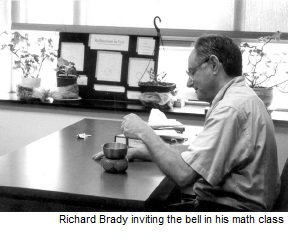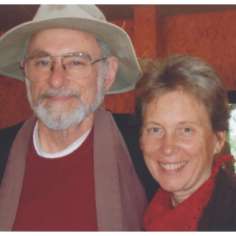Teaching as a Deep Learning Process
By Richard Brady in February 2005

During the June, 2004 Feet of the Buddha Retreat at Plum Village, a group of retreatants gathered to discuss ways of sharing mindfulness practice with young people. This prompted me to begin thinking freshly about my high school mathematics teaching.
My students learn new algebraic methods in a day and new topics in a month.
Teaching as a Deep Learning Process
By Richard Brady in February 2005

During the June, 2004 Feet of the Buddha Retreat at Plum Village, a group of retreatants gathered to discuss ways of sharing mindfulness practice with young people. This prompted me to begin thinking freshly about my high school mathematics teaching.
My students learn new algebraic methods in a day and new topics in a month. At the same time, there is deeper learning in process that will continue for the rest of their lives. This learning is about things such as perseverance, taking risks, and communicating with others. Ultimately it is about understanding themselves and the world.
Returning home, I pondered how my Plum Village experience could help me grow as a teacher. An insight that grew out of a conversation with Sister Jina helped me answer this question. I stayed at Plum Village for two weeks after the retreat ended, after most of my friends had left and the full schedule gave way to lazy days. I began to feel lonely, so I made an appointment with Sister Jina to talk about this loneliness and my practice at Plum Village.
Environments
At Plum Village feelings such as loneliness are more accessible to me because my usual busyness doesn’t keep them at bay. Also, fellow retreatants exemplify how to be in touch with and share their emotions. The safety and trust I feel comes from the quality of mindful listening and responding that I receive in Dharma discussions and other interactions. I really feel heard there.
The Plum Village environment often provides the context for deep learning, learning that changes my understanding of myself or of some aspect of the world. This is a significant ingredient of the learning process. As an educator, I place a high value on the consequences of the thinking that goes on in my classes. Though thinking occurs at the level of mind consciousness, Thay tells us that the origins of most behavior are found in the store consciousness. So deep learning occurs as the result of changes in the store consciousness. Such change can come about when a great deal of thought is given to a particular issue, but direct absorption by the store consciousness is a much more economical process. In this kind of learning, environment is a key factor.
I ask myself, “How can I create an environment in my competitive, college preparatory math classes spacious and safe enough for all of us to be in touch with our feelings and deeper questions? What can I do to promote mindful speech and deep listening in my classroom? For example, how might it affect the classroom environment if we sat in a circle some of the time as we do in Plum Village for Dharma discussions?”
Relationships
During my appointment with Sister Jina, a special moment occurred when she remarked, “There’s one thing I don’t understand. You said that everyone you’re close to has left the Upper Hamlet. That’s not true.” I scratched my head and waited for her to continue. After a pause, Sr. Jina said, “You are still here.” I can’t describe how I felt at that moment, but I recognized that I had just received a teaching that would continue to work inside me. Like a Zen koan, it is something I can sit with, practice with, and let ripen until, over time, a transformation can occur. How does a teaching have the potential to set this deep learning process in motion?
Sister Jina continued. “As a young person I was blessed to always be close to myself. However, I wasn’t aware of this until a time came when I lost it. I eventually recovered this closeness, and I have treasured it ever since.” This sharing of Sister Jina’s connected us at the heart level, helping me to open and receive it more deeply. I wonder how in teaching I can become more aware of what students are touching in me and teach from that place?
When Thay gives a teaching, each person in attendance understands the teaching differently, depending on his or her experience of life and of mindfulness practice. Those same differences occur in my students. Since much of our class time is spent working cooperatively in small groups, I’ve borrowed an idea from Thay, who once gave us stickers that said, “I walk for you” to put in our shoes. I give my students stickers that say, “I learn for you” to put on their textbook covers. Each student was having a different experience of cooperative learning through the year, but each time they opened their books, they were invited to be aware of whatever their current understanding was.

At the end of a school year, a student told me that it had taken him the entire year to understand the meaning of that sticker. The unfolding of the unique learning experience of each of my students is fundamentally a mystery. How can I do a better job of honoring and supporting it?
Practices
After receiving a teaching, the process of learning continues. It’s up to the student to integrate it into his or her life, which may or may not happen. Last spring I advised an algebra student to slow down and do the math just to do the math, not to try to get it finished in order to go on to the next thing. Intellectually she understood what I was saying. She wanted to follow my advice, but her habit energy of rushing was very strong, so she kept doing her work in the same way. In retrospect I see that she needed a concrete way to focus her mind as she worked so that she could develop new habits, some kind of practice. Perhaps it would have helped her to move a pebble from one pile to another and breathe in and out three times before starting each new problem.
My new insight about practicing being close to myself brought to mind the practice of chanting to Avalokiteshvara, the bodhisattva of compassion. I began doing this chant when the monastics invited the retreatants to join them during the closing of the retreat. My experience was so powerful that tears came to my eyes. I began to understand that watering the seed of my compassion is a way for me to be close to myself.
The store consciousness provides the internal environment for deep learning. When a teaching connects with well-developed seeds in the store consciousness, as Sister Jina’s did for me, the learning process unfolds in an organic way. Much of my students’ internal environment is unknown not only to me but also to them. I wonder how I can support them knowing themselves better so they can learn to draw on their own wisdom.
Obstacles
At Plum Village I continued sitting and walking, and chanting to Avalokiteshvara. I was aware of being in touch with myself more deeply. I brought my chanting practice home and continued trying to do it. However, e-mail, phone calls, a curriculum writing project at school, chores, and relationships began to overwhelm me. After several days spent with my extended family, I completely lost touch with myself.
During the retreat Thay told us that transformation comes about as the result of conditions that nurture the positive seeds in our store consciousness. It also comes about as the result of obstacles. Obstacles can become the basis for learning if we become aware of the misperceptions that have produced them. Obstacles are another ingredient of deep learning. Brother Pháp Tuê pointed out to me that when we feel stuck, there is an implication that this feeling is recurrent and that each time it seems as if it is the same feeling. However, actually the situation is constantly changing. We can see this if we look deeply, but we tend to avoid looking deeply because there is pain in the situation we don’t wish to face.
Being vs Doing
Through meditation and the support of friends who listened to my turmoil, I began to see what was happening. During my time in Plum Village, especially the last two weeks of quiet and solitude, I’d begun to get in touch with a young, tender part of myself, a flower nourished by my being-nature. Once home, all the old stimuli set my doing-nature in motion. My inner flower wilted. Losing this new experience of my being-nature was painful.
Looking deeply, I saw that my problems did not stem from all that I have to do but from my planning/reviewing habit of mind, a prominent characteristic I also see in my mother. When this part of my mind quieted down in Plum Village, I got in touch with the flower of my vulnerability. At home my planning and reviewing heritage shields me from these things. This defense mechanism is a part of me just as my vulnerability is. Embracing them both with great compassion is now my path of practice. I continue invoking Avalokiteshvara to water my seed of compassion so that it will be strong enough to hold both my vulnerability and my defenses.
When my students encounter obstacles, their first impulse is usually towards one of two extremes: they try to overcome them or they give up. The approach of welcoming obstacles, sitting with them, and seeing what gifts of understanding they have to offer is foreign to my students, yet it is one that could serve them well in life. I ask myself how I can do a better job of modeling this way of relating to difficulties in the classroom. I realize I can begin by curbing my impulses to diagnose and suggest remedies for students’ problems, and learn how to just be with the students and their problems.
I feel good about the direction my questions are taking me and look forward to practicing in the classroom. I’m aware that so much of my students’ lives are spent in ways that do not promote awareness. At best I can help them water their seeds of mindfulness for a brief time and trust that this will make a difference.
Readers interested in MiEN and its listserv can get information on the MiEN Website www.mindfuled.org.


